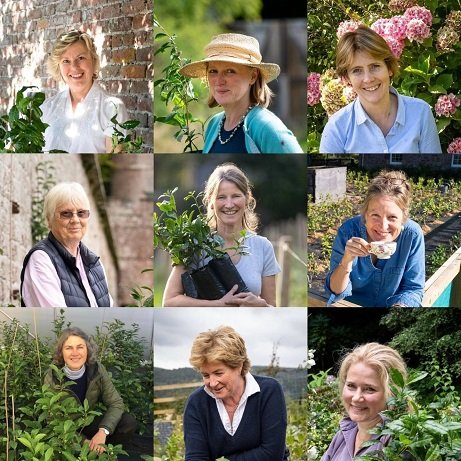Tea Gardens of Scotland
We are nine ladies, entrepreneurs, who are growing tea, making tea and selling tea from our tea gardens in Perthshire, Fife, Angus and Kincardineshire. Our artisanal tea, Nine Ladies Dancing, is made from the leaf picked from our combined gardens can be found in Fortnum and Mason, The Royal Penthouse Suite at the Corinthia and Bvlgari Hotel.
Our adventure in tea started in 2016 with a mission to produce authentic, hand-crafted Scottish tea. Each of us forged new careers as tea planters, transforming abandoned walled gardens, diversifying farms and converting home gardens. We have shared glasshouses, machinery, our trials and tribulations battling the Scottish elements and as a united force propagated tea plants from seed, planting them out in our distinctive sheltered micro-climates round the East Coast and Central Scotland where our slightly acidic soil, cold and low light levels in winter and endless daylight in summer significantly affect the flavour profile of our teas.
The result of our collaboration was the launch of Nine Ladies Dancing in 2020. This is a 100% pure Scottish-grown black tea. Golden, smooth and with sweet notes of dried fruits, caramel and chocolate, it is slightly woody, layered and complex.
We also have other teas available as our adventure continues.
Our Story
The nine of us came together in 2016 after one of our gardens produced it’s first 2 kg of black tea, Kinnettles Gold launched in 2015 from tea grown in polytunnels from cuttings, thereby proving a concept, that it was possible to grow and make delicious tea in Scotland. But tunnels are expensive and affording shelter to tea plants is one thing, growing tea outside in the fields as a crop was another and all nine of us were up to the challenge! Tea plants if grown from cuttings are shallow rooted and do not do well in high winds and frost, so specially selected cold tolerant tea seeds from Nepal and ex-soviet Georgia were imported. Tea grown from seed puts down lovely long tap roots, to mine down for goodies in the soil and they anchor better in storms!
We saw the planting of tea as a way of utilising spaces that were either neglected like old walled gardens, or parts of fields that were difficult to get farm machinery into. Mostly these were sheltered, but not always and tea plants loathe high winds above all else. It was incredibly hard work - often neglected areas had to be weeded, either using the help of pigs, or rotivating and putting in a cover crop like clover. Glasshouses were rented, 41,000 seeds germinated, our families and children pressed into service helping fill sleeves to transplant seedlings into. Then came the shipment out of the glasshouses of the tea plants to be planted out in the nine gardens in 2017. The hard work really started in our first winter. We had a grant to help us from LEADER so innovative materials were trialed as wind breaks and protection from frost, but the first winter took a heavy toll and infilling the following spring was required. Some of our gardens put down weed suppressant fabric around the plants to reduce the weeding burden as labour is so expensive, hoping the plants would grow quickly, reach out to each other and cut out the light to the weeds, but it is Scotland and they do not grow that fast! Our Scottish wildlife ensured a few more set backs. Deer love tea, so do rabbits and voles!
A succession of winters have made us more innovative, some of the gardens using sheep wool for mulch, guards, manure, and weeding to prevent burst bark around the collars of the plants. The Beast from the East nearly finished us as nets protecting plants had to be cleared of wet heavy snow, often collapsing on top of the plants.
When our tea plants were mature enough in 2020 to get a very small yield we were grateful that there were nine of us to combine our small plucks. We had just enough for Fortnums Rare Tea Counter! It is a huge challenge growing tea in Scotland and each gardens plucking schedule due to locations, some more coastal, some higher, than others means plucking times vary.
Our plants are still undergoing formative pruning and won't reach maturity for a further couple of years, which is why there are currently such small quantities of tea being produced. By coming together as a group we have also able to protect the provenance of our tea by working with Aberdeen University to prove the authenticity of Scottish tea using ionomics which test the elements in the leaf that come through from the soil. Tea grown, plucked and processed in Scotland is so rare and so much work goes into it that consumers need the confidence that what they purchase really is grown on Scottish soil and is Scottish tea - a unique artisanal product and we want to protect this going forward.
As the tea plants begin to mature, the ambition for the Tea Gardens of Scotland collective is to secure a reputation as world class tea producers, promoting tea tourism and riding the revolutionary wave of authentic, hand-crafted Scottish tea. Our tea journey has relied on tea learning, consultancy help, courses, travel to see different tea processing techniques and equipment in Japan, India, Nepal, Sri-lanka. Up until now our Nine Ladies Dancing has been made and processed in small batches by the Scottish Tea Factory. From this season on as our tea journey develops our group is plucking our leaf and processing our own tea collectively as we dance our way into 2023.

